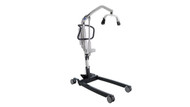In the realm of residential care, as residents age, their ability to move independently diminishes. Consequently, they increasingly rely on care staff for assistance with transfers, which can pose significant risks associated with hazardous manual handling. It's worth noting that the healthcare sector ranks as the leading industry for serious workers' compensation claims in Australia, with a substantial portion of these claims stemming from the hazardous manual handling of patients (WorkSafe Victoria).
Employers in this sector bear a critical responsibility to minimise the risk of hazardous manual handling for their employees, while maintaining the highest standard of care for residents. The recommended approach for mitigating the risks associated with hazardous manual handling is the utilisation of mechanical lifting aids, such as mobile floor hoists and standing hoists.
Mobile Floor Hoists: A mobile floor hoist is a versatile device available in various sizes and weight capacities to accommodate residents. Powered by electricity, it is designed to lift residents who are unable to move themselves, facilitating transfers between a bed and a chair, and vice versa. The mobile floor hoist features a sling that envelops the resident and is securely attached to the hoist via clips or loops. Once the hoist and sling are safely connected, staff can execute patient transfers with ease. It is imperative, however, that before using a mobile floor hoist, staff ensure it is in good working condition and has undergone its annual service. Additionally, it's crucial to confirm that the resident's weight falls within the safe working load of the hoist. Slings should be tailored to each specific patient, visually inspected for holes or tears before each use, and equipped with up-to-date testing labels (required every 6 months).
Standing Hoists: Standing hoists are suitable for residents who can bear weight on at least one leg but still require assistance during transfers. They contribute to preserving a resident's independence and strength while significantly reducing the risk of hazardous manual handling for staff. Standing hoists are available in both powered and non-powered versions. Powered standing hoists employ a sling that can attach to the hoist via loop or clip attachments and secure around the resident's torso or abdomen. Once the sling and hoist are properly attached, staff can encourage the resident to begin standing, with the lifting function assisting in the process.
In conclusion, prioritising safe patient handling through the use of mechanical lifting aids not only enhances the quality of resident care but also safeguards the well-being of healthcare workers by mitigating the risks associated with hazardous manual handling.
26th Oct 2023
